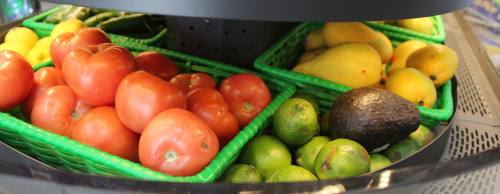If her husband is unable to drive her to the nearest full-service grocery store, 78745 resident Gloria Najera said she must walk to purchase healthy, affordable food. The round-trip amounts to approximately one hour on foot.
“When my husband cannot take me to the grocery store, I walk to the Wal-Mart near my house,” she said. “If I want to go to H-E-B or Fiesta, it’s a 30- to 45-minute walk each way. I only purchase what is light and easy to carry.”
Najera lives within what the United States Department of Agriculture identifies as a “food desert,” or a location where people live more than a quarter mile away from a full-service grocery store in an urban area and 10 miles away in a rural area. Residents living within food deserts are labeled as food-insecure.
“A quarter-mile doesn’t seem like a very long distance for a healthy and fit individual to get to a grocery store without a vehicle, but when you compound that with low-income individuals and seniors without good sidewalk infrastructure, they can barely walk an eighth of a mile to get to a grocery store, much less a mile,” said Edwin Marty, food policy manager with the city’s office of sustainability.
 The link between poverty, food insecurity
The link between poverty, food insecurity
According to a 2016 study from the national nonprofit Feeding America titled “Map the Meal Gap 2016: Food Insecurity and Child Food Insecurity Estimates at the County Level,” which analyzed 2014 U.S. Census Bureau data, food insecurity across South Austin ZIP codes ranges from approximately one in 10 to one in five people.
The data shows that food insecurity is prevalent in areas with high levels of poverty, low annual median household income, high unemployment rates and large populations of minority residents.
In the 78745 ZIP code, about 18 percent of residents are classified as food-insecure, and about 16 percent live below the poverty line. The area also has the highest unemployment rate in South Austin at approximately 7 percent, and the annual median household income is the lowest in the region at $52,949. Demographics show 39.5 percent of residents are Hispanic, and 5.9 percent are African-American.ZIP codes with higher annual median household incomes have lower levels of food insecurity than their regional counterparts, the data shows. Only 8.9 percent of people in 78739, which includes neighborhoods such as Circle C, are classified as food-insecure, and only 3.7 percent of residents live in poverty.
Food insecurity looks slightly different in the neighboring communities, said Carmen Llanes Pulido, community director of Go! Austin /¡VAMOS! Austin, or GAVA, a coalition of residents, community leaders and nonprofits working to increase access to improved nutrition and physical activity in the 78744 and 78745 ZIP codes.
The full-service grocery stores that exist in 78745 are located on the ZIP code’s perimeter, Pulido said, rendering them widely inaccessible for families living in the core of the ZIP code, many of whom, Pulido said, have only one vehicle per family. She called 78745 a “food swamp” where unhealthy dining options dominate.
“There are a lot of unhealthy options in 78745,” Pulido said. “It is hard for people to get those healthy options, even if they don’t seem too far away.”
The availability of low-income housing in the peripheral parts of town drives families out of the urban core, Marty said, and into areas such as South Austin where rent is less expensive, but full-service grocery stores are scarce.
“We are seeing a migration of poverty out of the urban core into the periphery of Austin, away from the core services that make living in poverty easier,” he said.
Where significant pockets of poverty exist, so do a lack of grocery stores, Marty said.
“We are talking miles [of distance between residents and a full-service grocery store],” he said.
The result is a large swath of residents relegated to purchasing food from area corner stores—businesses not typically known to carry a wide selection of nutritious food. But according to Marty, there are local organizations working toward a change.
“A movement is sweeping the country to insert healthy, affordable food into corner stores,” Marty said.
In 2015, GAVA began its Healthy Corner Store Initiative with the help of a grant from the city’s health department, Pulido said. The initiative encourages local corner store owners to stock healthy, affordable food.
“The initiative was born out of the desire to put more healthy food within walking distance of people, but to also incorporate a small-business model,” she said.
The Bread Basket, located in Sunset Valley, was the first store to join the initiative, Pulido said. Longtime owner Baslan Omar worked with the organizers of GAVA and 78745 residents, such as Najera, to increase his inventory of healthy items, including fresh fruits and vegetables, as well as dry and non-perishable items.
“We walked our neighborhood to receive community surveys, and we negotiated prices with the [corner store] managers to make the healthy items more affordable,” Najera said. “My family and I use the Bread Basket to purchase onions, chiles, potatoes, limes and tomatoes, and I can walk there for these items.”
According to Omar, the initiative has turned a profit. He recently purchased a larger container to stock his increased selection of fruits and vegetables.
“We had some healthy foods, but only a small amount, so we thought we would give it a chance and see how it works,” he said.
‘Social determinants of health’
Efforts such as GAVA’s can change what Marty referenced as the “social determinants of health,” or the idea that one’s ZIP code can determine how one dies and when. In South Austin, Marty said the result is shortened life spans due to dietary habits.
“What we see is low-income families are basically having to compromise on the types of food they want to buy versus what they can afford, and these decisions radically impact health,” Marty said.
Without access to a full-service grocery store, low-income families are left with limited options for nutritious foods.
“When you are on a budget, you make compromises about where to cut costs,” he said. “You can’t negotiate rent or the phone bill, but you can negotiate your food bill.”
Although she is unaware of any data that directly links food insecurity to health in the Austin area, Elisha Hall, a research associate with Feeding Texas, a subsidiary of Feeding America, said it would be reasonable to draw comparisons between data on health outcomes with regional food insecurity rates.
According to a 2012 Community Health Needs Assessment by the national organization Community Commons which aims to create healthy, equitable, and sustainable communities, about 33-36 percent of adults over the age of 18 in South Austin ZIP codes are classified as overweight or have a body mass index between 25 and 29. According to the CDC, a normal or healthy body mass index is between 18.5 and 24.9.
“The basic reality is there is a direct correlation between food insecurity and obesity,” Marty said. “It’s very difficult for people to understand how people can be hungry and obese. Cheap, low-quality food is very affordable.”
What is the solution?
Instead of building grocery stores in food-insecure areas, which drives up the value of nearby residences, Marty said the city must practice strategic affordable housing.
“It is absolutely necessary to develop dense, multifamily affordable housing along existing corridors where there is already food retail and good public transit,” Marty said.
Marty said he is hopeful the work of nonprofits like GAVA combined with thoughtful city planning can alter the trajectory of food insecurity in areas such as South Austin.
“Food insecurity is about as critical of [a] piece of the puzzle [as] you can get for long-term societal well-being,” he said.





